Solving the whodunit of Topanga Beach
January 8, 2013
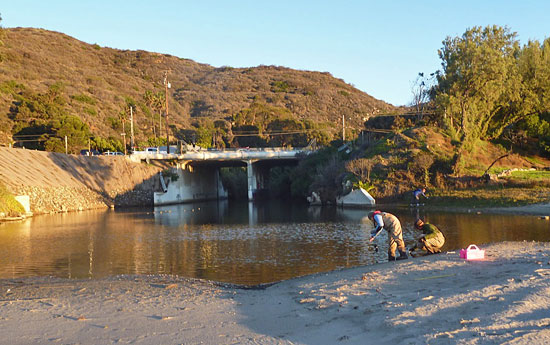
Scientists from UCLA and Santa Monica Mountains Resource Conservation District take samples from the Topanga Lagoon. Photo/Rosi Dagit
It has been a mystery now for almost a decade: What’s polluting the water at Topanga State Beach?
Once regarded as one of the cleanest stretches of ocean in Los Angeles County, Topanga fell from grace around 2003, when high bacteria levels sank its water quality score on Heal the Bay’s annual Beach Report Card.
Although cleanup efforts were diligent, testing methods couldn’t pinpoint the source of the problem. Theories abounded. Was it someone’s leaky septic system? Birds and coyotes? Illegal dumping upstream in Topanga Creek?
“We thought it might be the old septic system at the public restrooms,” says Rosi Dagit, senior conservation biologist for the Santa Monica Mountains Resource Conservation District. “So that was redone and replaced with a state-of-the-art system. Then we thought it might be the old septic systems in the rodeo grounds upstream from the lagoon, so those were removed, too.”
But the problem remained. “We kept taking out potential sources of bacteria,” Dagit says, “and the beach kept getting these high numbers.” Consequently, even though other types of pollution are markedly low at Topanga, the beach has been more or less a regular on Heal the Bay’s official “Beach Bummers” 10-worst-beaches list.
Now Topanga Beach has become the focus of an in-depth study that will seek to finally nail down the reason behind the chronically high levels of total coliform, fecal coliform and enterococcus bacteria, which may make swimmers sick.
Piggybacking on a larger statewide look at beach pollution hotspots that began in 2010, the new, two-year look at Topanga, which began in November, will sample water up to twice monthly from as many as 10 locations on Topanga State Beach and along the lower section of the creek that feeds the lagoon there. The samples then will be subjected to rigorous DNA testing.
The study also will examine the connection between tiny invertebrates and nutrient levels in the water, along with why the generally normal bacteria levels in the creek tend to spike when the water hits the lagoon and ocean, says Dagit. There’ll also be an educational component, with opportunities for school children to visit the testing labs at UCLA and learn how to help keep Southern California’s water clean.
The added scrutiny—expected to cost $550,000 during the study’s two years—is being funded through an allocation from the office of Los Angeles County Supervisor Zev Yaroslavsky. The Topanga effort is being jointly overseen by UCLA, which is a local lead on the statewide study, and the Resource Conservation District. Dagit, the county’s point-person on the project, says the tests are complex and relatively new.
“You have to collect the samples before sunlight hits the water,” she says, “because the sun makes bacteria go crazy. So we’ve been getting up at night and going down to the water before sun-up. Our last sampling was December 19, and let me tell you, it was cold.”
The tests also are expensive—about $200 per half-gallon water sample—but have come down markedly in cost over the past few years.
Scientists are enthusiastic about the study’s prospects.
“It’s like DNA fingerprinting of bacteria,” says Dagit. “We’ll be able to find out not only whether the source is human or non-human, but if it’s non-human, whether it’s from gulls, dogs, coyotes or horses and whether it came from a direct deposit on the beach, or from gray water or a septic system.”
That’s important, she says, because bacteria from a natural source, such as wildlife, requires a different set of solutions than does bacteria from the feces of pets and humans. “Suppose those bacteria levels are because of a lot of gulls roosting at Topanga Lagoon,” Dagit says. “We don’t want people swimming in water with high bacterial levels, but we don’t want to get rid of the gulls.”
Dagit says that, by this time next year, scientists should have many more clues to the mystery at Topanga Beach.
“It should be pretty amazing,” she says. “We haven’t really had the technology to do this kind of study until now.”
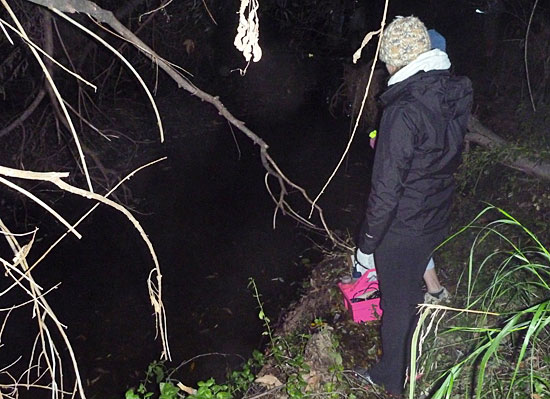
UCLA grad student Amy Zimmer-Faust and Senior Conservation Biologist Rosi Dagit collect bacteria samples by night in Topanga Creek. Photo/Tim Riedel
Posted 1/2/13
Transforming a prime beach vista
January 8, 2013
The dirt lot overlooking the sand at Coastline Drive and Pacific Coast Highway has been vacant for three decades or so. Once it held a beachfront café owned by the restaurateur who started Gladstones. Then fire destroyed the place twice in five years.
So it sat, roped off and abandoned, little more than a cluster of faded parking spots and wooden pilings, as homeowners resisted the opening of a new restaurant along the already congested highway; after a while, passersby forgot that much of anything had ever been there.
This week, however, the county took the first steps in a $9.5 million plan to re-open the 1.9-acre site and make the beach there more welcoming to the public, starting with a spacious view deck that will not only provide improved passage to the shoreline, but also offer a stunning view down the coast toward Santa Monica Pier.
“This will be a great place to stop and listen to the waves and enjoy the sunset,” said Charlotte Miyamoto, chief of the county Department of Beaches and Harbors’ planning division.
“This will finally make use of an area that hasn’t been visited much,” Miyamoto added. “Right now, there’s a bus stop there and not much more.”
This wasn’t always the case. The site, at the northwesterly end of Will Rogers State Beach across PCH from the entrance to the Getty Villa, was once the location of an oceanfront café owned by Robert Morris, who in the 1980s was one of Los Angeles’ best known restaurant owners.
The spot had had an eatery on it since 1976, when the county had approved a summer concession and snack bar. A later restaurant on the site, Jetty’s, started by Morris and a partner, burned down twice—once in 1979 and again in 1984, according to Coastal Commission records.
After that, hopes dimmed for a comeback; at one point, Morris announced plans to reopen the restaurant, rename it the Malibu Deck and make it part of a proposed “restaurant row” of oceanfront dining on public beaches.
But the pushback was powerful. Pacific Palisades homeowners protested that a new beachfront restaurant would worsen congestion and generate crime, garbage and noise. And the state and county couldn’t agree on a plan for such an enterprise on the site. (Much of the state’s beach property here is operated by Los Angeles County and the lease revenue would have helped the county’s general fund in the midst of a recession, but the state was less enthusiastic at the time.)
Eventually, without a design that met current building and safety codes for the area, the restaurant lease was terminated. The empty lot was roped off and anyone who stopped at the site in hopes of a beach shortcut had to make their way down a steep embankment, where they found little more than those 52 ghostly-looking pilings and a narrow strip of sand.
By the late 1990s, the county had begun to explore ways to reopen the site’s beach access, but it took years to negotiate a workable plan with the California Coastal Commission. Among the sticking points were initial plans to shore up the bluff with a rock-covered, sloping embankment, which coastal commissioners felt was too intrusive. Eventually, the commission called for a 610-foot-long, 15-foot-high seawall that added several million dollars to the cost of the project, but preserved more of the beach.
The current design, approved this week by the Board of Supervisors, will create a refurbished, 26-space parking lot next to a landscaped, 2,100-square-foot public view deck, from which pedestrians can access the beach via an ADA-compliant access ramp.
Construction costs are estimated at $5.76 million, plus some $3.5 million for plans, plan checks, consulting services and other construction costs. The project is set to break ground in April, with completion expected in October, 2014.
Posted 1/8/13
Taking aim at weapons
January 4, 2013
In the aftermath of last month’s horrific Sandy Hook Elementary School shooting, we once again find ourselves talking about how we must reduce gun violence and confront the easy access our society provides to weaponry that, in the wrong hands, can inflict mass carnage. As both a member of the Los Angeles City Council and the county Board of Supervisors, I’ve long been a proponent of sensible gun regulation—especially when it comes to automatic and semi-automatic firearms, including assault rifles, that gunmen have wielded in several of the more recent shooting tragedies. But they’ve also been used plenty of times in the past.
After the Newtown murders of 20 children and six adults, I was instantly taken back to an incident here that had the potential to be even worse than it was. In 1999, a gunman opened fire with an assault rifle at the North Valley Jewish Community Center in Granada Hills, wounding three children, a teenaged camp counselor and a receptionist. He was accused of later killing a mail carrier in Chatsworth.
This came just two years after two bank robbers in North Hollywood pinned down overmatched Los Angeles police officers with automatic weapons fire before the criminals were finally killed. Some of those firearms were traced to the nation’s largest gun show—held on the L.A. County-owned fairgrounds in Pomona. It made no sense to me that public property would be used to sell weapons of all kinds, some of which would end up on our streets and contribute to what was then an epidemic of violent crime.
So I proposed a ban on the sale of guns on any county property, including the fairgrounds. Two of my colleagues, Supervisors Gloria Molina and Yvonne Burke, joined me in passing this historic ban. The gun show owners filed suit against the county. But the California Supreme Court in 2002 affirmed our right to ban the sale of guns on our publicly-owned property.
More than a decade earlier, in early 1989, I successfully sponsored an emergency ordinance banning the sale and possession of semi-automatic weapons in the City of Los Angeles. Not only were they becoming the weapon of choice for L.A.’s notoriously violent street gangs, but just a month earlier, a gunman in Stockton, armed with an AK-47, had killed five schoolchildren and injured more than two dozen. I felt compelled to act because our Sacramento lawmakers had procrastinated for too long on legislation banning assault weapons. The City Council approved my proposal, and weeks later, the State legislature acted, fearing that hundreds of cities would each pass their own bans.
I’ve always believed there are two principal reasons to responsibly regulate gun sales in our communities.
First, the harder we make it for people to get their hands on military-style assault weapons, the less likely it is that such weapons will be used. Have these laws, passed both locally and nationally, made a difference? Did they save lives? Undoubtedly they did, although we’ll never know how many. But if these restrictions have saved one life, then it’s worth it. I’ve been around long enough to know that one of the great shortcomings in our society is that too many of us make the perfect be the enemy of the good. While no one law or regulation will completely eliminate gun violence from our society, that’s no reason to do nothing. The one guarantee we have is that if we don’t try, we’ll get no results.
The second reason, which is rarely talked about, is one of messaging. Leaders and opinion makers in politics, religion, business, public health, law enforcement and elsewhere make a difference when they take a public stand on an issue of this societal magnitude. The Board of Supervisors sent a strong message when it banned the sale of guns on county property, not only because it might save lives but because by doing so we were saying that this kind of activity is not acceptable. Just as we’ve changed the culture of smoking in our country over the last generation, the culture of easy access to military-style assault weapons can be changed as well. When the largest county in the nation says “no” to the sale of guns on its property, it’s taking a giant step toward changing that culture.
That’s why I strongly support California U.S. Senator Dianne Feinstein’s plan to reintroduce her federal ban on assault weapons, which expired in 2004. If approved, her legislation will not just save lives in the short run, it will also send a clear message that enough is enough, that weapons with the devastating power to take lives and kill dreams in Newtown, Aurora, Columbine or San Fernando Valley have no place in our communities. When we ban assault weapons, we begin to stigmatize their ownership. When we allow them on the free market, we’re essentially saying that these weapons are consistent with the values we collectively hold dear. Well, in any civilized society, these values should never trump the value of a human life, and that’s why I hope you’ll join me in supporting Senator Feinstein’s efforts.
Posted 1/4/13
Noontime Namaste
January 3, 2013
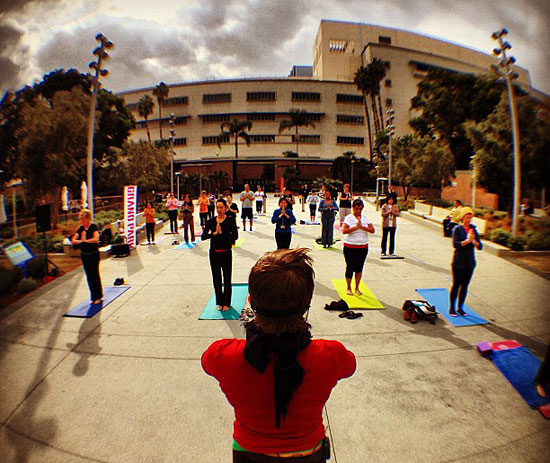
Christel Joy Johnson's yoga class has become one of Grand Park's most popular programs. Photo/Javier Guillen
Christel Joy Johnson has a resolution for all you desk-bound downtowners: Come see her at lunchtime—and breathe.
Since November, Johnson has been leading one of the most popular public programs at Downtown Los Angeles’ new Grand Park, a free lunch-hour yoga class. The free 45-minute sessions have been drawing passersby, office workers and downtown hipsters, who’ve gathered by the score in a performance space between Grand Avenue and Hill Street for the gentle midday workouts, even in inclement winter weather.
“We thought we’d get maybe ten people,” Johnson says laughing. “The first time we held the class, 50 people showed up.”
Since then, she says, the classes—at 12:15 p.m. on Wednesdays and Fridays—have averaged 30 to 40 students.
“It’s everybody from county workers on their lunch break and Music Center employees to people who come by bus or walk over from apartments and bring their yoga mats with them,” she says.
“It’s getting so I’m starting to see some of the same faces. There are two girls in the front who live downtown and have been there for every session. I imagine with New Year’s resolutions we’ll get even bigger when we start up again on January 9.”
The Wisconsin-born Johnson, 39, didn’t set out to become the unofficial yogi of a major metropolitan civic center. Like so many in L.A.’s service sector, she came here to act.
Arriving in her mid-20s with a degree in theater arts from San Francisco State, she says, she gravitated toward small ensembles; she is currently a member of the local theater group Ghost Road Company. Work as a production assistant on films and at the Music Center helped underwrite her stage career, she says, “but theater doesn’t pay a lot, so I had to do other jobs to pay the bills.”
One of those other jobs was yoga, which she had taken up while she was a student to help mitigate the lingering effects of an assortment of old back injuries.
“About six years ago,” she says, “I became really serious about it, and in 2009, I did a 3-month teacher training at the YogaWorks in Larchmont Village, where I had taken some classes.”
At first, she says, the intensive training was a personal challenge and a means of coping with a series of illnesses in her immediate family. Over time, however, she found she enjoyed the challenge and the personal contact.
She’s taught in fitness centers, community classes and for private clients. But for all her skill at saluting the sun and assuming the “downward dog” position, it was her theater network that led to the Grand Park gig. From the outset, park programmers had talked about yoga classes as a way to entice the brown-bag lunch crowd away from their desks and into the fresh air.
“I’d been a part-time production assistant at the Music Center for eight years,” she says, “and the Music Center does the programming for Grand Park. When they decided they wanted to do yoga classes, and that they wanted to produce something themselves rather than team up with a studio, someone mentioned that I taught yoga and they approached me.” Though the classes are open and free to the public, the Music Center pays Johnson for her time.
“I love it,” she says simply. “You’re outside. You have the sky and the trees. Hummingbirds fly around the group as we do our class. And it’s really cute—people in business suits at the Starbucks will often take in our energy as they sit there watching. One day, a group of ladies in very nice clothes was just quietly doing yoga with us in their chairs.”
About a third of the group is male, she says, and ages range from twentysomething to seventysomething. Most, though, are middle-aged beginners who appreciate her ability to help them tailor the positions to build flexibility.
“As someone who loves yoga and thinks it’s a beautiful thing for the community, I hope the program grows,” Johnson says, noting the success of other outdoor programs such as the free daily yoga in Hollywood’s Runyon Canyon Park.
For now, she and her students are just glad that the lunch-hour yoga has been extended for another quarter. “It’s probably not going to lead to acting jobs,” she says, laughing. “But that’s not why I do it.”
Posted 1/3/13
Lights out for L.A. Christmas trees
January 3, 2013
The end of the holidays can be such a grind.
Particularly for the hundreds of thousands of Los Angeles County Christmas trees being chopped up, ground down or otherwise looking for a new line of work in the days and weeks ahead.
Yes, it’s the most resolution-making time of the year, and prominent among all the do-good messaging is the mantra to go green by recycling that tree. The city of L.A. is touting the fire safety benefits along with the environmental upside, while the county is promoting convenient curbside pickup to have ol’ tannenbaum transformed into “compost, mulch, or ground cover.” But the reality of L.A. Christmas trees’ final chapter is a little more complicated than it might seem, with different approaches in place in the county’s various communities and plenty of ground up trees ending up covering a variety of sins in local landfills as “alternative daily cover.”
Sure, some of these former glitter kings of the living room go on to a bucolic-sounding afterlife. The 100,000 or so trees picked up by the city of Los Angeles’ Bureau of Sanitation, for example, are made into mulch and used as ground cover here or sent to farms in Kern and Ventura counties. (Residents can pick up a free bag year-round at any of the locations on this city map.) Santa Monica’s Christmas trees—some 25 tons of them—are chipped at local parks and pressed into landscaping duty around town; the 2011 crop is now serving as mulch at the Santa Monica Airport.
In Avalon, teams of fourth-graders, guided by the Catalina Island Conservancy, recycle several hundred trees each year by placing them in gullies where they provide natural erosion control. First, the kids strip off all the tinsel and other “unnatural parts” like ornaments or tree stands, then work together to move the trees to gullies where they’ll hold soil in place and make it possible for new plants to grow.
Other Christmas trees—some 386,235 last year—are off on a whole different kind of sleigh ride. These trees, from unincorporated communities and about 80 cities throughout the county, are picked up by trash haulers and trucked to local landfills, where they’re ground up to become “alternative daily cover”—the stuff they put over the trash every night to keep things tidy and reduce odors. It may not be the most glamorous job on the Christmas tree lot, but somebody’s gotta do it—and county officials say it’s a beneficial form of recycling permitted under state law.
Under the program, trash haulers from participating cities drop off the Christmas trees at the landfills free of charge.
“I personally believe alternative daily cover is a great market for this material. It’s a pretty great use in these urban markets, rather than hauling it away” to be converted into compost at a faraway facility, says Nick Morell, recycling coordinator for the county Sanitation Districts. He said the ground-up Christmas trees take the place of dirt that would otherwise have to be trucked in and used as cover.
The recycled Christmas tree cover also lessens smells, prevents fires, reduces dust and “keeps critters away,” says Pat Proano, assistant deputy director of the environmental programs division for the county’s Department of Public Works.
While composting would be a “preferred option” for retired Christmas trees, Proano says, there’s not enough of a local agricultural market for all that would be produced in a county the size of Los Angeles. “We’re not farmers,” he says. “The quantities are huge.”
Still, Proano says, this year’s planned closure of the county’s Puente Hills landfill, the nation’s largest, will require some rethinking of how the county recycles its Christmas trees before the next holiday season rolls around.
As things stand now, Proano says, most residents are “probably not” aware of where their Noble fir or Scotch pine will end up after their trash hauler picks it up curbside.
“They’re just probably glad to have the service,” he says. (To check out what’s going on in your community, click here for a list of contact numbers and websites. Please note that different cities have different requirements—Los Angeles asks that residents cut their trees into pieces small enough to fit into their green yard waste bins, for instance, whereas Santa Monica requests that trees be kept out of the bin and dropped off at parks. No matter when you live, tinsel must be removed along with decorations and tree stands before pick-up, and flocked trees are generally frowned upon.)
Getting the inside story of what actually happens to the family fir after it’s left at the curb can be a bit traumatic, as a group of Long Beach students learned last year.
“They were totally disillusioned,” recalls Lisa Harris, the city’s top recycling specialist. She says the Rogers Middle School students had wanted to research the happy hereafter of Christmas trees. “They were hoping the trees were going to be turned into a buttery compost”—not pressed into service for “alternative beneficial use” in landfills.
However or wherever a real Christmas tree meets its end, it’s a good environmental outcome, in the view of Rick Dungey, public relations manager for the National Christmas Tree Association.
“There are so many things you can do with it because it’s a plant,” he says. (For instance, discarded Christmas trees in Riverside County are being placed in Lake Elsinore to create fish habitat.)
Dungey’s no fan of the faux tree, which he terms “a giant green toilet brush” that’s destined for a non-biodegradable future in a landfill someday.
His organization estimates that 30.8 million real Christmas trees were sold in the United States in 2011, along with 9.5 million artificial trees. They don’t do regional breakdowns, but that translates roughly to one real tree for every ten residents.
Already looking ahead to next year? Sunset magazine’s take on the pros and cons of real and artificial trees is here. And—just as reusable bags have offered a way around the eternal paper vs. plastic debate at the grocery checkout—there could be a third holiday decorating option to consider come next December: rented live Christmas trees, for those who can’t bear to send their evergreen to the great beyond.
Posted 1/3/13





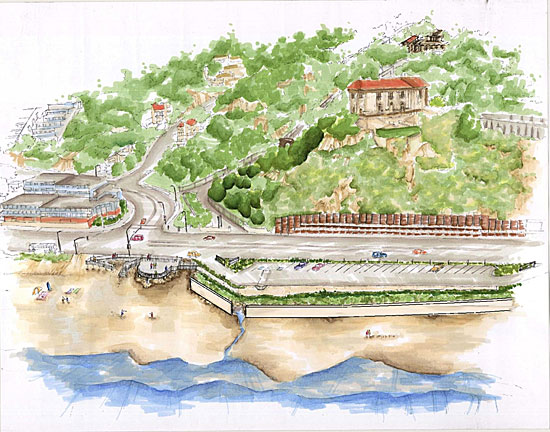

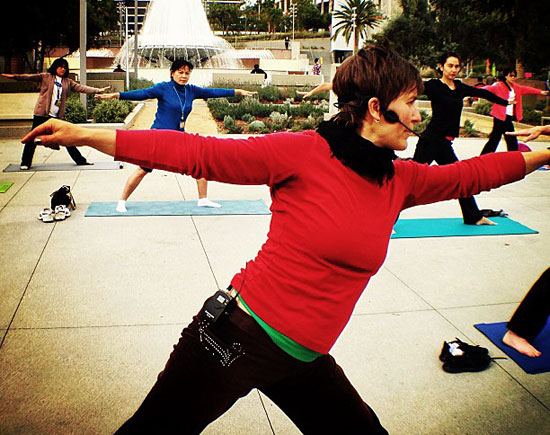
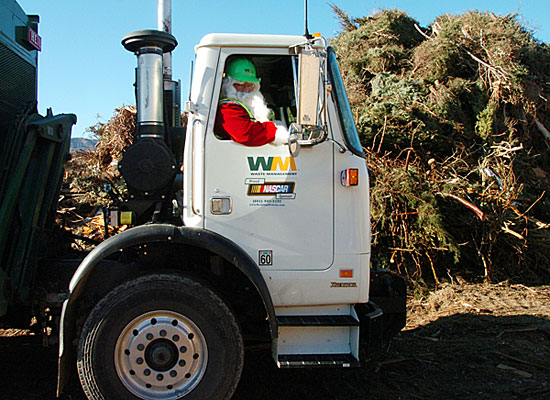
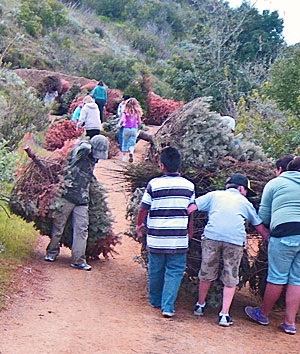
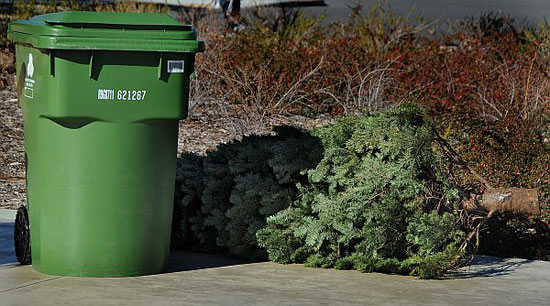





 Check for the latest closure information
Check for the latest closure information








